Revaluation and Impairment Loss: A Comprehensive Study Report
VerifiedAdded on 2023/06/05
|12
|2092
|188
Report
AI Summary
This report provides a detailed analysis of asset revaluation and impairment loss, focusing on the application of IAS 136 accounting standards. It examines two articles discussing impairment loss and asset revaluation, highlighting their similarities and differences in determining the true value of assets. The report covers the implementation of impairment tests, the use of cash-generating units (CGUs), and the implications for accountants, accounting regulators, and external users such as shareholders and government entities. It emphasizes the importance of transparent financial reporting and compliance with IFRS rules to accurately reflect asset values and ensure informed investment decisions. This document is available on Desklib, where students can find a wealth of study resources including past papers and solved assignments.
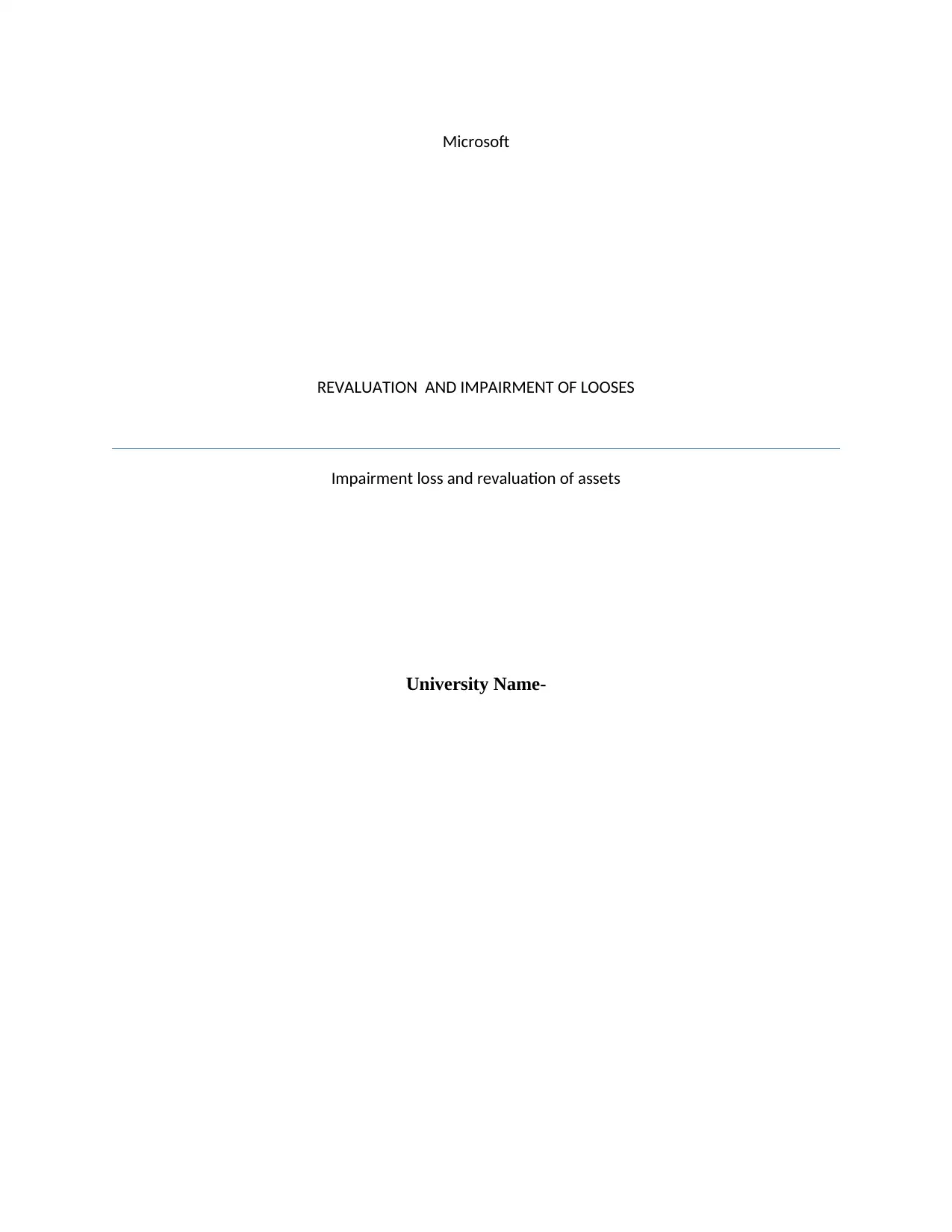
Microsoft
REVALUATION AND IMPAIRMENT OF LOOSES
Impairment loss and revaluation of assets
University Name-
REVALUATION AND IMPAIRMENT OF LOOSES
Impairment loss and revaluation of assets
University Name-
Paraphrase This Document
Need a fresh take? Get an instant paraphrase of this document with our AI Paraphraser
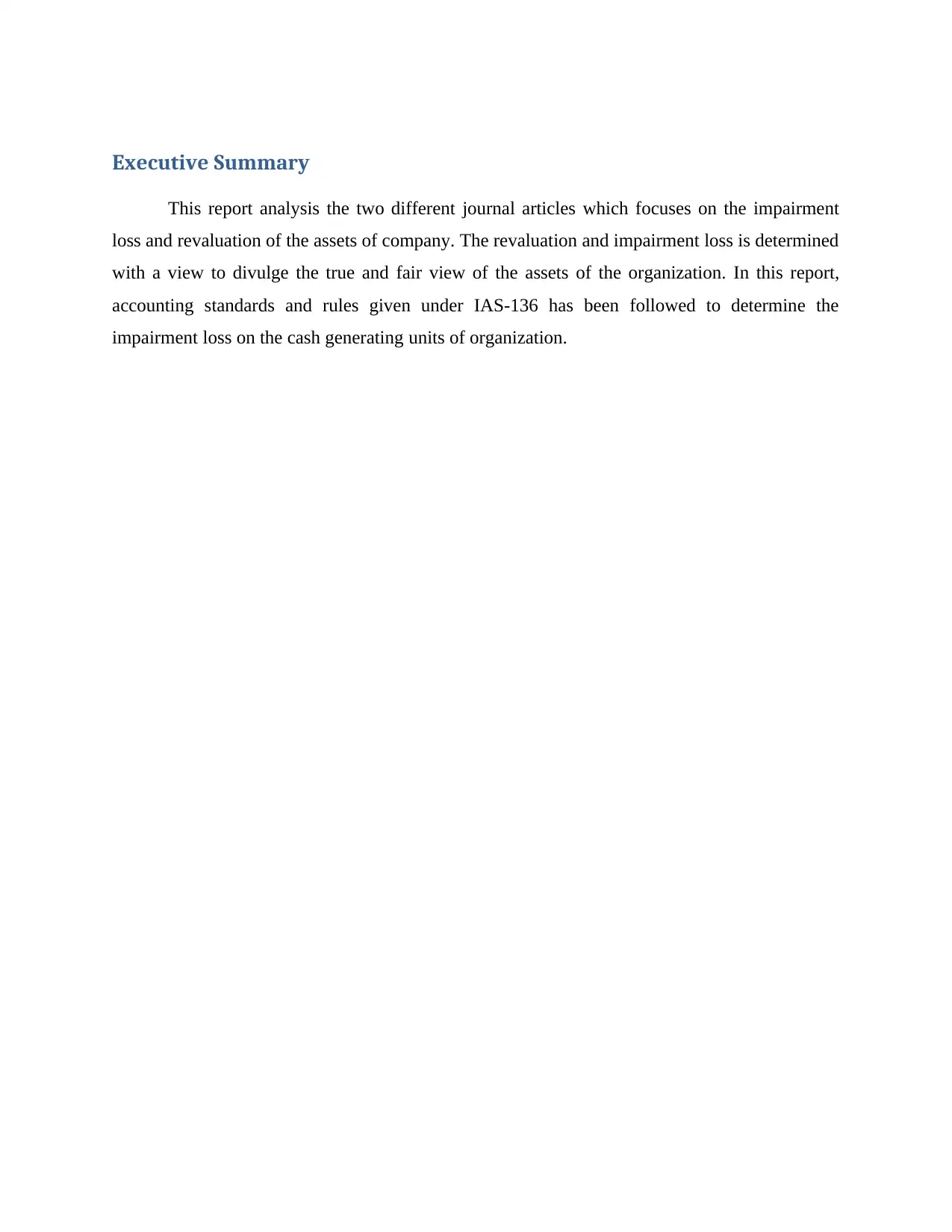
Executive Summary
This report analysis the two different journal articles which focuses on the impairment
loss and revaluation of the assets of company. The revaluation and impairment loss is determined
with a view to divulge the true and fair view of the assets of the organization. In this report,
accounting standards and rules given under IAS-136 has been followed to determine the
impairment loss on the cash generating units of organization.
This report analysis the two different journal articles which focuses on the impairment
loss and revaluation of the assets of company. The revaluation and impairment loss is determined
with a view to divulge the true and fair view of the assets of the organization. In this report,
accounting standards and rules given under IAS-136 has been followed to determine the
impairment loss on the cash generating units of organization.
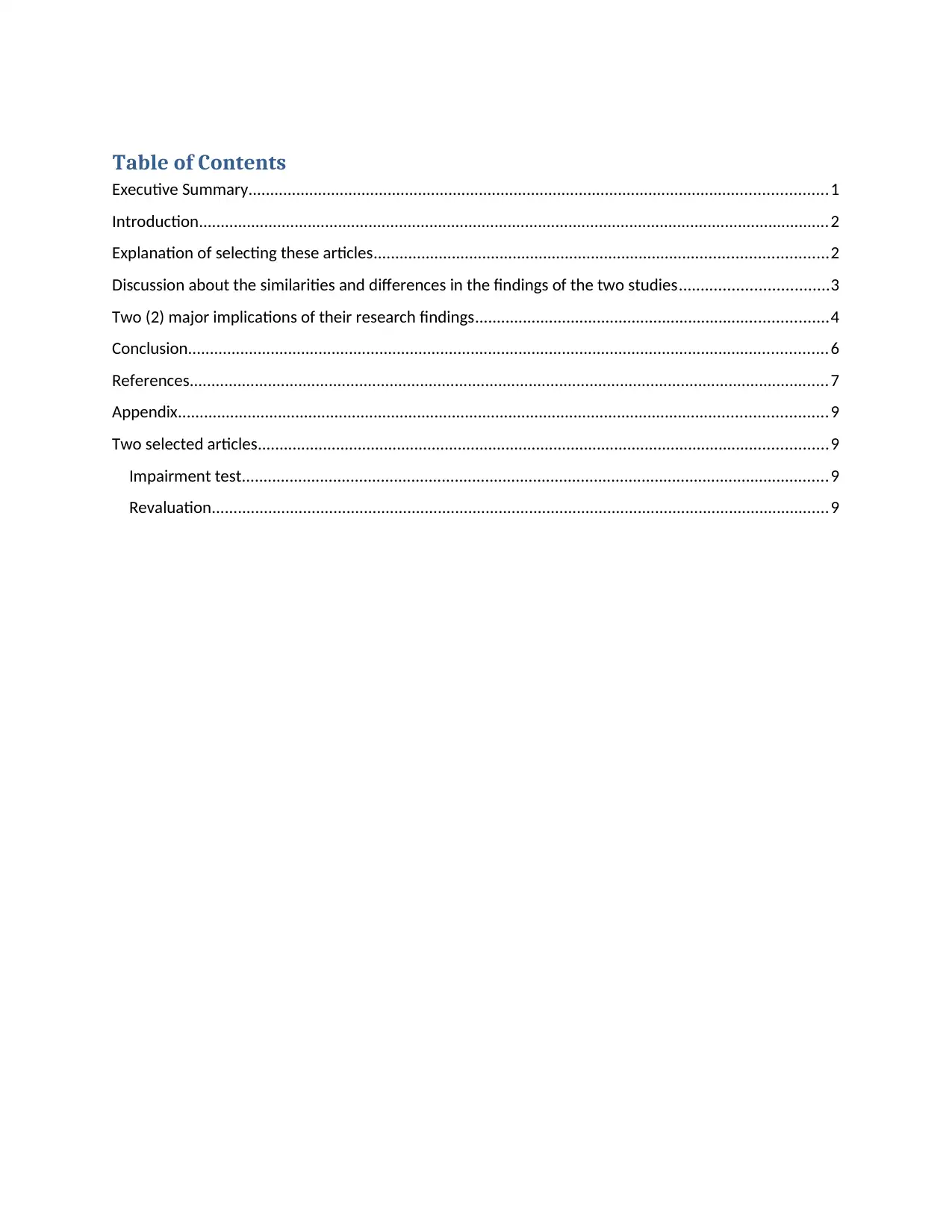
Table of Contents
Executive Summary.....................................................................................................................................1
Introduction.................................................................................................................................................2
Explanation of selecting these articles........................................................................................................2
Discussion about the similarities and differences in the findings of the two studies..................................3
Two (2) major implications of their research findings.................................................................................4
Conclusion...................................................................................................................................................6
References...................................................................................................................................................7
Appendix.....................................................................................................................................................9
Two selected articles...................................................................................................................................9
Impairment test.......................................................................................................................................9
Revaluation..............................................................................................................................................9
Executive Summary.....................................................................................................................................1
Introduction.................................................................................................................................................2
Explanation of selecting these articles........................................................................................................2
Discussion about the similarities and differences in the findings of the two studies..................................3
Two (2) major implications of their research findings.................................................................................4
Conclusion...................................................................................................................................................6
References...................................................................................................................................................7
Appendix.....................................................................................................................................................9
Two selected articles...................................................................................................................................9
Impairment test.......................................................................................................................................9
Revaluation..............................................................................................................................................9
⊘ This is a preview!⊘
Do you want full access?
Subscribe today to unlock all pages.

Trusted by 1+ million students worldwide
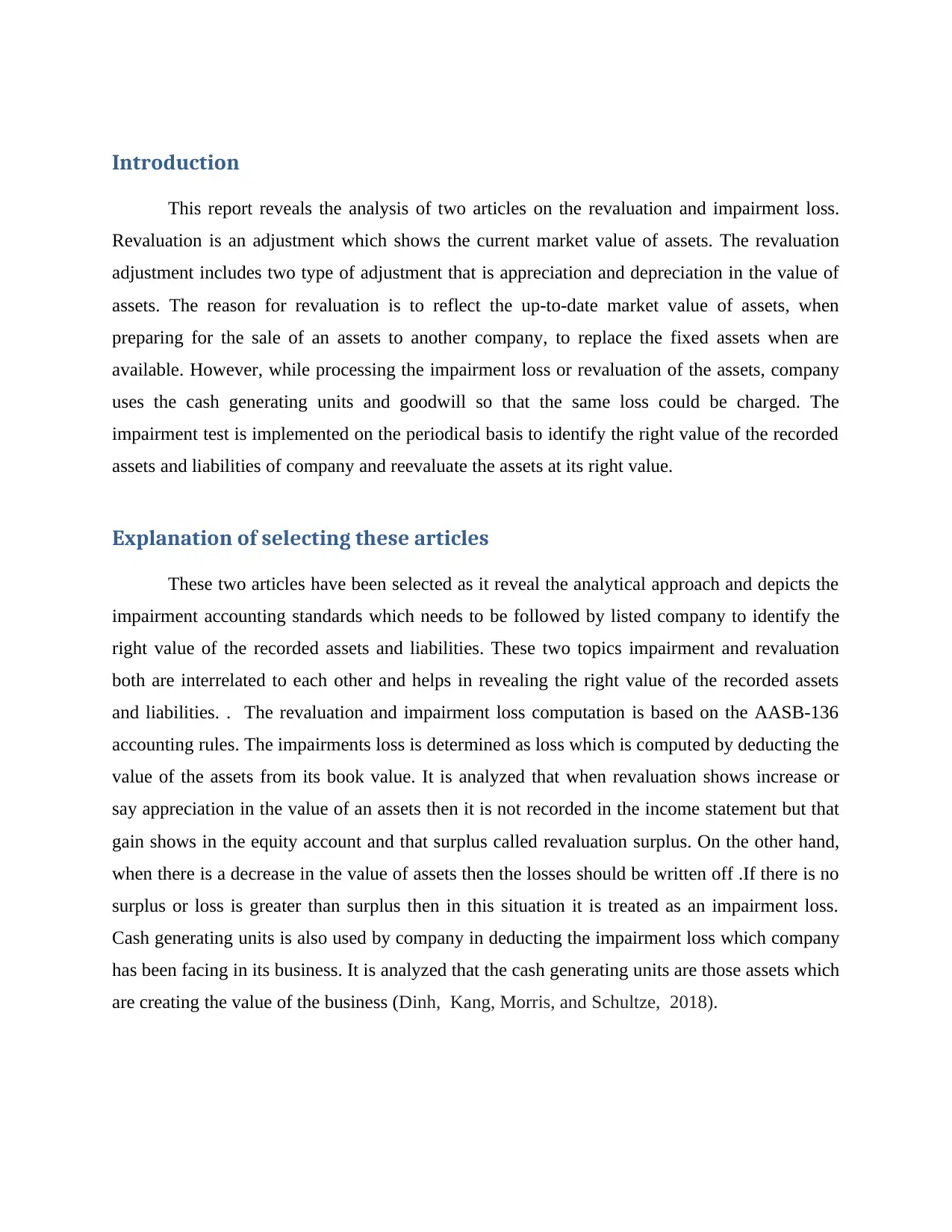
Introduction
This report reveals the analysis of two articles on the revaluation and impairment loss.
Revaluation is an adjustment which shows the current market value of assets. The revaluation
adjustment includes two type of adjustment that is appreciation and depreciation in the value of
assets. The reason for revaluation is to reflect the up-to-date market value of assets, when
preparing for the sale of an assets to another company, to replace the fixed assets when are
available. However, while processing the impairment loss or revaluation of the assets, company
uses the cash generating units and goodwill so that the same loss could be charged. The
impairment test is implemented on the periodical basis to identify the right value of the recorded
assets and liabilities of company and reevaluate the assets at its right value.
Explanation of selecting these articles
These two articles have been selected as it reveal the analytical approach and depicts the
impairment accounting standards which needs to be followed by listed company to identify the
right value of the recorded assets and liabilities. These two topics impairment and revaluation
both are interrelated to each other and helps in revealing the right value of the recorded assets
and liabilities. . The revaluation and impairment loss computation is based on the AASB-136
accounting rules. The impairments loss is determined as loss which is computed by deducting the
value of the assets from its book value. It is analyzed that when revaluation shows increase or
say appreciation in the value of an assets then it is not recorded in the income statement but that
gain shows in the equity account and that surplus called revaluation surplus. On the other hand,
when there is a decrease in the value of assets then the losses should be written off .If there is no
surplus or loss is greater than surplus then in this situation it is treated as an impairment loss.
Cash generating units is also used by company in deducting the impairment loss which company
has been facing in its business. It is analyzed that the cash generating units are those assets which
are creating the value of the business (Dinh, Kang, Morris, and Schultze, 2018).
This report reveals the analysis of two articles on the revaluation and impairment loss.
Revaluation is an adjustment which shows the current market value of assets. The revaluation
adjustment includes two type of adjustment that is appreciation and depreciation in the value of
assets. The reason for revaluation is to reflect the up-to-date market value of assets, when
preparing for the sale of an assets to another company, to replace the fixed assets when are
available. However, while processing the impairment loss or revaluation of the assets, company
uses the cash generating units and goodwill so that the same loss could be charged. The
impairment test is implemented on the periodical basis to identify the right value of the recorded
assets and liabilities of company and reevaluate the assets at its right value.
Explanation of selecting these articles
These two articles have been selected as it reveal the analytical approach and depicts the
impairment accounting standards which needs to be followed by listed company to identify the
right value of the recorded assets and liabilities. These two topics impairment and revaluation
both are interrelated to each other and helps in revealing the right value of the recorded assets
and liabilities. . The revaluation and impairment loss computation is based on the AASB-136
accounting rules. The impairments loss is determined as loss which is computed by deducting the
value of the assets from its book value. It is analyzed that when revaluation shows increase or
say appreciation in the value of an assets then it is not recorded in the income statement but that
gain shows in the equity account and that surplus called revaluation surplus. On the other hand,
when there is a decrease in the value of assets then the losses should be written off .If there is no
surplus or loss is greater than surplus then in this situation it is treated as an impairment loss.
Cash generating units is also used by company in deducting the impairment loss which company
has been facing in its business. It is analyzed that the cash generating units are those assets which
are creating the value of the business (Dinh, Kang, Morris, and Schultze, 2018).
Paraphrase This Document
Need a fresh take? Get an instant paraphrase of this document with our AI Paraphraser
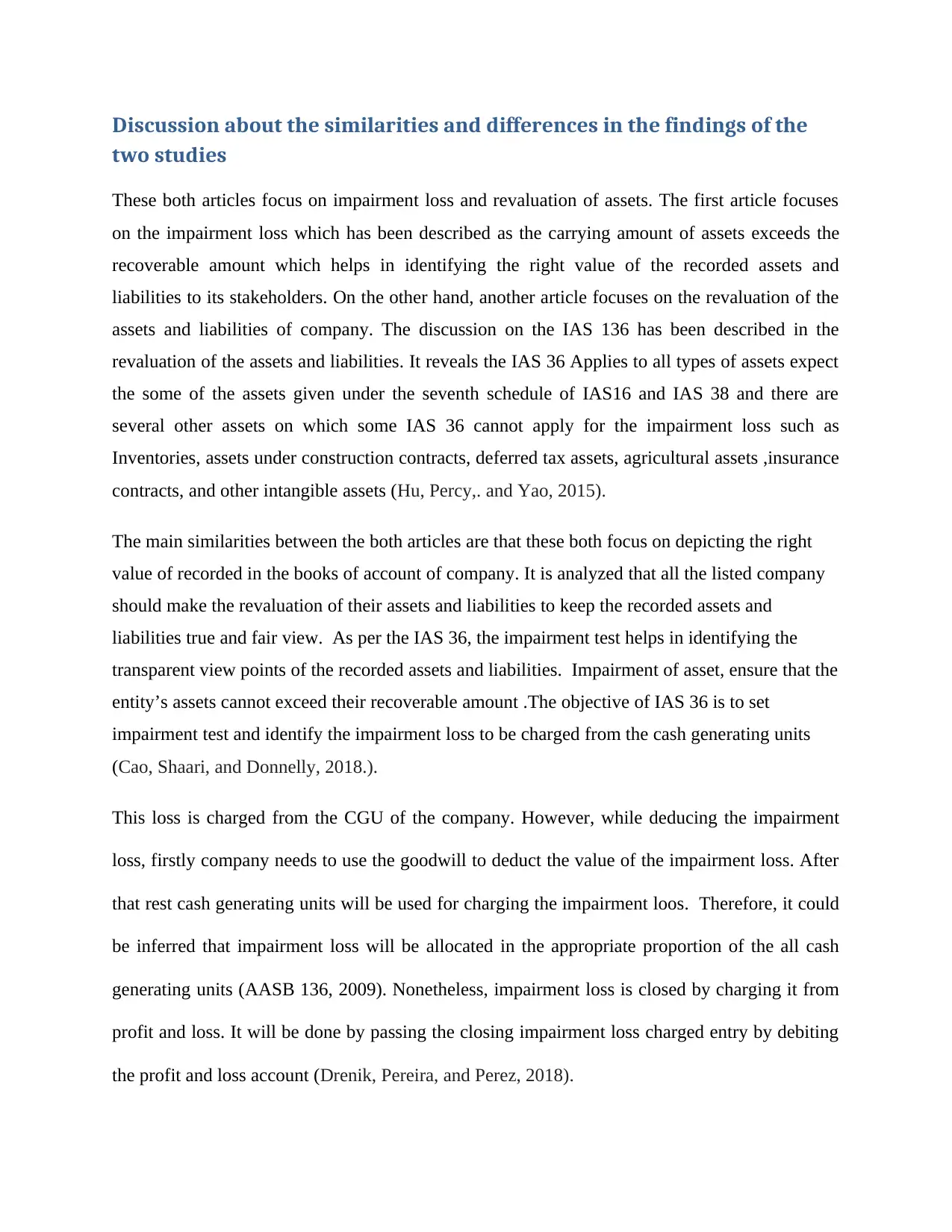
Discussion about the similarities and differences in the findings of the
two studies
These both articles focus on impairment loss and revaluation of assets. The first article focuses
on the impairment loss which has been described as the carrying amount of assets exceeds the
recoverable amount which helps in identifying the right value of the recorded assets and
liabilities to its stakeholders. On the other hand, another article focuses on the revaluation of the
assets and liabilities of company. The discussion on the IAS 136 has been described in the
revaluation of the assets and liabilities. It reveals the IAS 36 Applies to all types of assets expect
the some of the assets given under the seventh schedule of IAS16 and IAS 38 and there are
several other assets on which some IAS 36 cannot apply for the impairment loss such as
Inventories, assets under construction contracts, deferred tax assets, agricultural assets ,insurance
contracts, and other intangible assets (Hu, Percy,. and Yao, 2015).
The main similarities between the both articles are that these both focus on depicting the right
value of recorded in the books of account of company. It is analyzed that all the listed company
should make the revaluation of their assets and liabilities to keep the recorded assets and
liabilities true and fair view. As per the IAS 36, the impairment test helps in identifying the
transparent view points of the recorded assets and liabilities. Impairment of asset, ensure that the
entity’s assets cannot exceed their recoverable amount .The objective of IAS 36 is to set
impairment test and identify the impairment loss to be charged from the cash generating units
(Cao, Shaari, and Donnelly, 2018.).
This loss is charged from the CGU of the company. However, while deducing the impairment
loss, firstly company needs to use the goodwill to deduct the value of the impairment loss. After
that rest cash generating units will be used for charging the impairment loos. Therefore, it could
be inferred that impairment loss will be allocated in the appropriate proportion of the all cash
generating units (AASB 136, 2009). Nonetheless, impairment loss is closed by charging it from
profit and loss. It will be done by passing the closing impairment loss charged entry by debiting
the profit and loss account (Drenik, Pereira, and Perez, 2018).
two studies
These both articles focus on impairment loss and revaluation of assets. The first article focuses
on the impairment loss which has been described as the carrying amount of assets exceeds the
recoverable amount which helps in identifying the right value of the recorded assets and
liabilities to its stakeholders. On the other hand, another article focuses on the revaluation of the
assets and liabilities of company. The discussion on the IAS 136 has been described in the
revaluation of the assets and liabilities. It reveals the IAS 36 Applies to all types of assets expect
the some of the assets given under the seventh schedule of IAS16 and IAS 38 and there are
several other assets on which some IAS 36 cannot apply for the impairment loss such as
Inventories, assets under construction contracts, deferred tax assets, agricultural assets ,insurance
contracts, and other intangible assets (Hu, Percy,. and Yao, 2015).
The main similarities between the both articles are that these both focus on depicting the right
value of recorded in the books of account of company. It is analyzed that all the listed company
should make the revaluation of their assets and liabilities to keep the recorded assets and
liabilities true and fair view. As per the IAS 36, the impairment test helps in identifying the
transparent view points of the recorded assets and liabilities. Impairment of asset, ensure that the
entity’s assets cannot exceed their recoverable amount .The objective of IAS 36 is to set
impairment test and identify the impairment loss to be charged from the cash generating units
(Cao, Shaari, and Donnelly, 2018.).
This loss is charged from the CGU of the company. However, while deducing the impairment
loss, firstly company needs to use the goodwill to deduct the value of the impairment loss. After
that rest cash generating units will be used for charging the impairment loos. Therefore, it could
be inferred that impairment loss will be allocated in the appropriate proportion of the all cash
generating units (AASB 136, 2009). Nonetheless, impairment loss is closed by charging it from
profit and loss. It will be done by passing the closing impairment loss charged entry by debiting
the profit and loss account (Drenik, Pereira, and Perez, 2018).
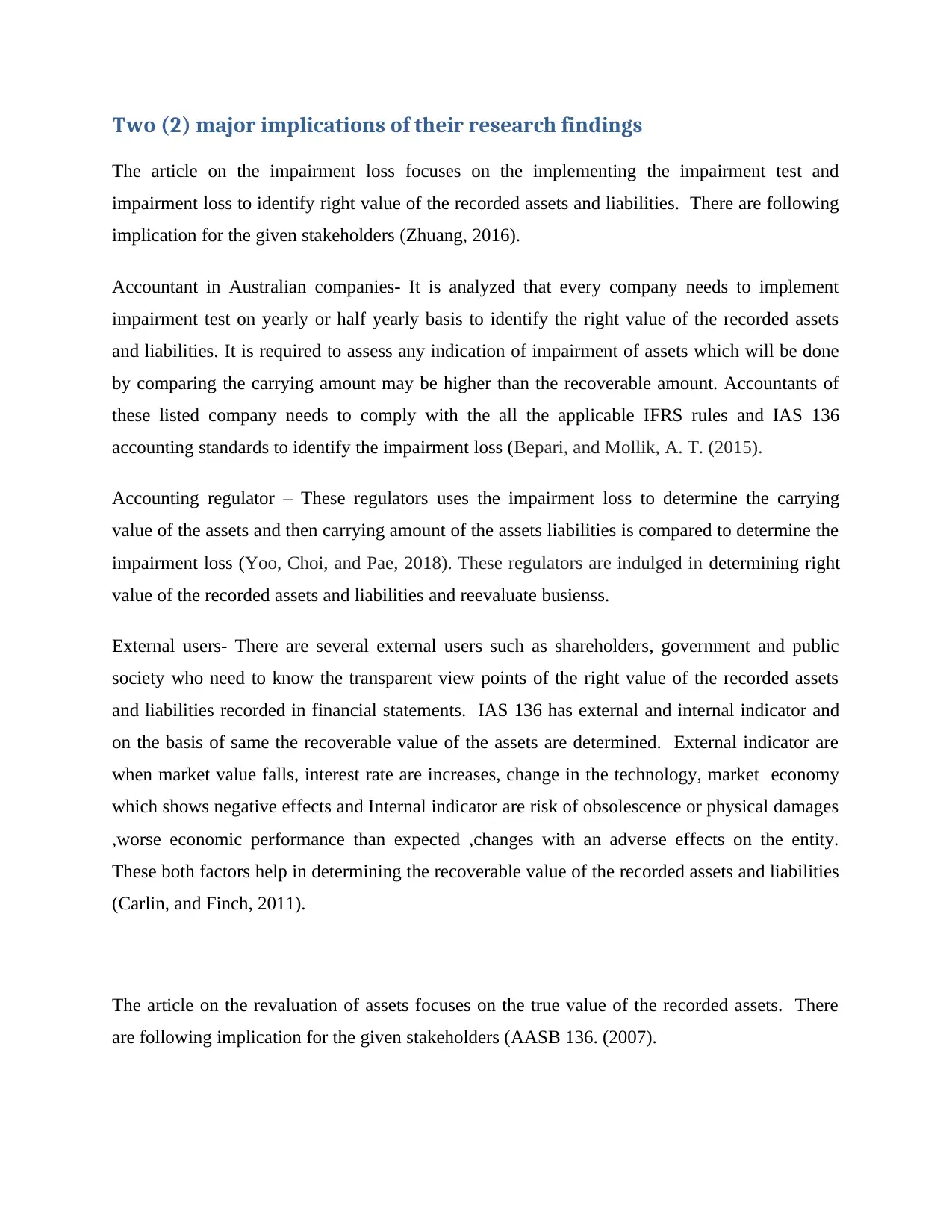
Two (2) major implications of their research findings
The article on the impairment loss focuses on the implementing the impairment test and
impairment loss to identify right value of the recorded assets and liabilities. There are following
implication for the given stakeholders (Zhuang, 2016).
Accountant in Australian companies- It is analyzed that every company needs to implement
impairment test on yearly or half yearly basis to identify the right value of the recorded assets
and liabilities. It is required to assess any indication of impairment of assets which will be done
by comparing the carrying amount may be higher than the recoverable amount. Accountants of
these listed company needs to comply with the all the applicable IFRS rules and IAS 136
accounting standards to identify the impairment loss (Bepari, and Mollik, A. T. (2015).
Accounting regulator – These regulators uses the impairment loss to determine the carrying
value of the assets and then carrying amount of the assets liabilities is compared to determine the
impairment loss (Yoo, Choi, and Pae, 2018). These regulators are indulged in determining right
value of the recorded assets and liabilities and reevaluate busienss.
External users- There are several external users such as shareholders, government and public
society who need to know the transparent view points of the right value of the recorded assets
and liabilities recorded in financial statements. IAS 136 has external and internal indicator and
on the basis of same the recoverable value of the assets are determined. External indicator are
when market value falls, interest rate are increases, change in the technology, market economy
which shows negative effects and Internal indicator are risk of obsolescence or physical damages
,worse economic performance than expected ,changes with an adverse effects on the entity.
These both factors help in determining the recoverable value of the recorded assets and liabilities
(Carlin, and Finch, 2011).
The article on the revaluation of assets focuses on the true value of the recorded assets. There
are following implication for the given stakeholders (AASB 136. (2007).
The article on the impairment loss focuses on the implementing the impairment test and
impairment loss to identify right value of the recorded assets and liabilities. There are following
implication for the given stakeholders (Zhuang, 2016).
Accountant in Australian companies- It is analyzed that every company needs to implement
impairment test on yearly or half yearly basis to identify the right value of the recorded assets
and liabilities. It is required to assess any indication of impairment of assets which will be done
by comparing the carrying amount may be higher than the recoverable amount. Accountants of
these listed company needs to comply with the all the applicable IFRS rules and IAS 136
accounting standards to identify the impairment loss (Bepari, and Mollik, A. T. (2015).
Accounting regulator – These regulators uses the impairment loss to determine the carrying
value of the assets and then carrying amount of the assets liabilities is compared to determine the
impairment loss (Yoo, Choi, and Pae, 2018). These regulators are indulged in determining right
value of the recorded assets and liabilities and reevaluate busienss.
External users- There are several external users such as shareholders, government and public
society who need to know the transparent view points of the right value of the recorded assets
and liabilities recorded in financial statements. IAS 136 has external and internal indicator and
on the basis of same the recoverable value of the assets are determined. External indicator are
when market value falls, interest rate are increases, change in the technology, market economy
which shows negative effects and Internal indicator are risk of obsolescence or physical damages
,worse economic performance than expected ,changes with an adverse effects on the entity.
These both factors help in determining the recoverable value of the recorded assets and liabilities
(Carlin, and Finch, 2011).
The article on the revaluation of assets focuses on the true value of the recorded assets. There
are following implication for the given stakeholders (AASB 136. (2007).
⊘ This is a preview!⊘
Do you want full access?
Subscribe today to unlock all pages.

Trusted by 1+ million students worldwide
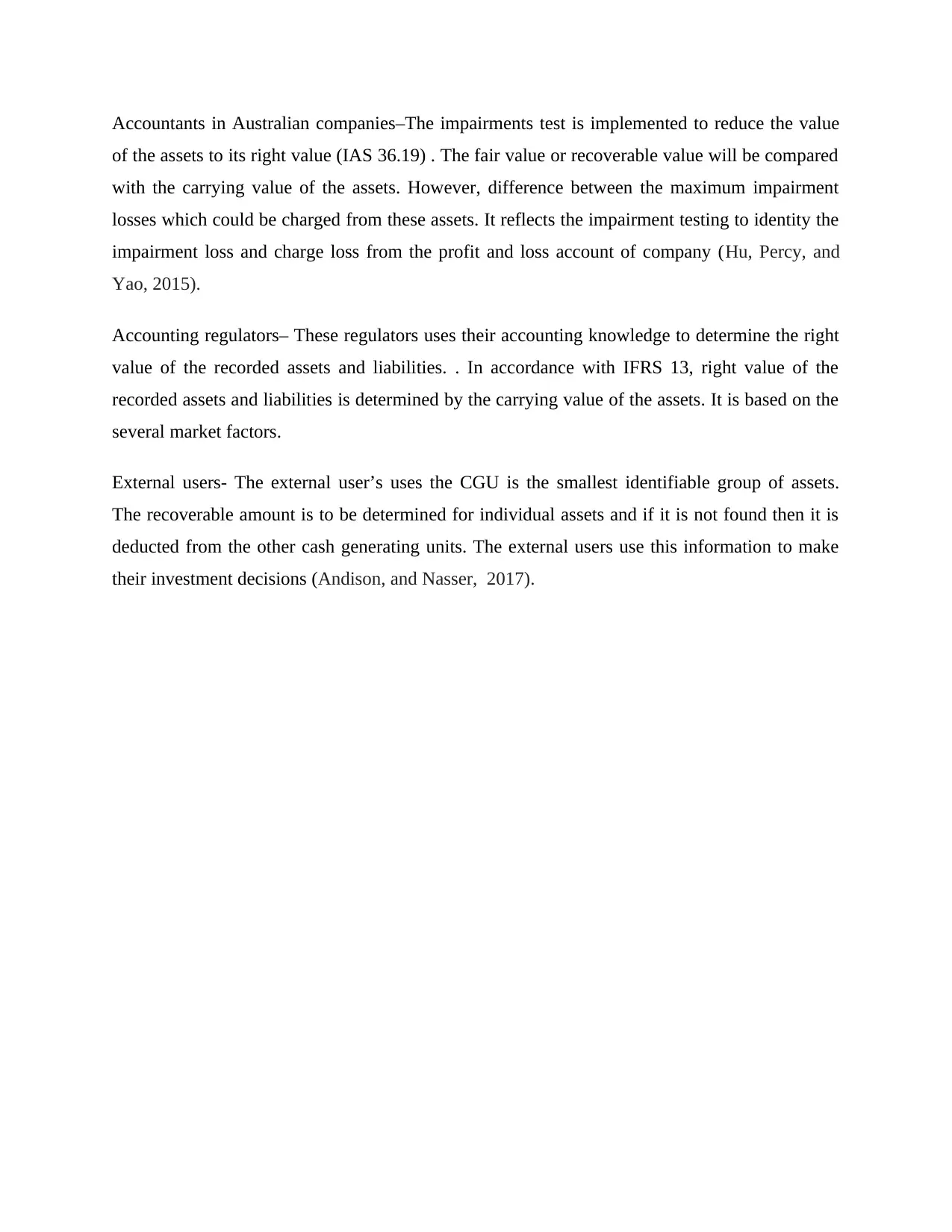
Accountants in Australian companies–The impairments test is implemented to reduce the value
of the assets to its right value (IAS 36.19) . The fair value or recoverable value will be compared
with the carrying value of the assets. However, difference between the maximum impairment
losses which could be charged from these assets. It reflects the impairment testing to identity the
impairment loss and charge loss from the profit and loss account of company (Hu, Percy, and
Yao, 2015).
Accounting regulators– These regulators uses their accounting knowledge to determine the right
value of the recorded assets and liabilities. . In accordance with IFRS 13, right value of the
recorded assets and liabilities is determined by the carrying value of the assets. It is based on the
several market factors.
External users- The external user’s uses the CGU is the smallest identifiable group of assets.
The recoverable amount is to be determined for individual assets and if it is not found then it is
deducted from the other cash generating units. The external users use this information to make
their investment decisions (Andison, and Nasser, 2017).
of the assets to its right value (IAS 36.19) . The fair value or recoverable value will be compared
with the carrying value of the assets. However, difference between the maximum impairment
losses which could be charged from these assets. It reflects the impairment testing to identity the
impairment loss and charge loss from the profit and loss account of company (Hu, Percy, and
Yao, 2015).
Accounting regulators– These regulators uses their accounting knowledge to determine the right
value of the recorded assets and liabilities. . In accordance with IFRS 13, right value of the
recorded assets and liabilities is determined by the carrying value of the assets. It is based on the
several market factors.
External users- The external user’s uses the CGU is the smallest identifiable group of assets.
The recoverable amount is to be determined for individual assets and if it is not found then it is
deducted from the other cash generating units. The external users use this information to make
their investment decisions (Andison, and Nasser, 2017).
Paraphrase This Document
Need a fresh take? Get an instant paraphrase of this document with our AI Paraphraser
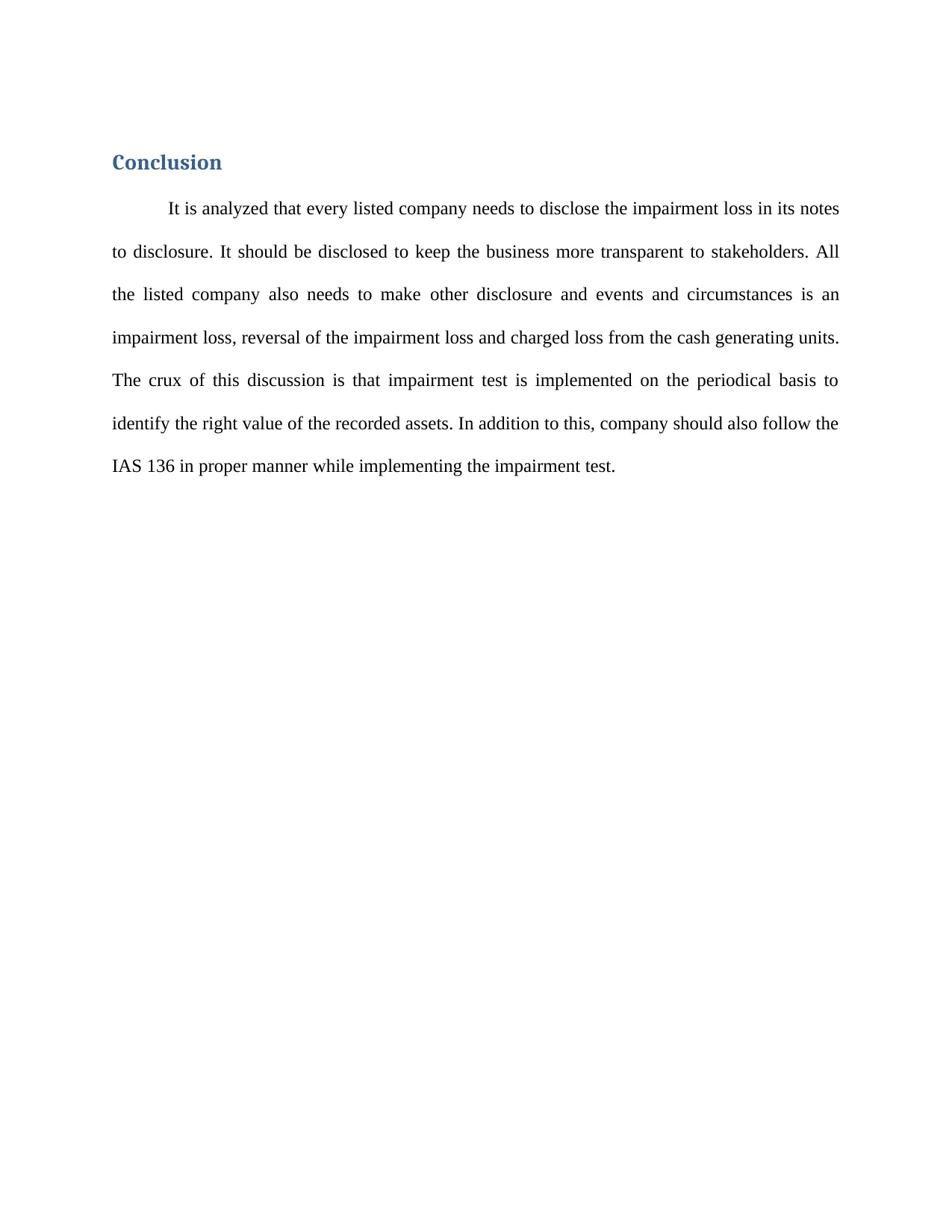
Conclusion
It is analyzed that every listed company needs to disclose the impairment loss in its notes
to disclosure. It should be disclosed to keep the business more transparent to stakeholders. All
the listed company also needs to make other disclosure and events and circumstances is an
impairment loss, reversal of the impairment loss and charged loss from the cash generating units.
The crux of this discussion is that impairment test is implemented on the periodical basis to
identify the right value of the recorded assets. In addition to this, company should also follow the
IAS 136 in proper manner while implementing the impairment test.
It is analyzed that every listed company needs to disclose the impairment loss in its notes
to disclosure. It should be disclosed to keep the business more transparent to stakeholders. All
the listed company also needs to make other disclosure and events and circumstances is an
impairment loss, reversal of the impairment loss and charged loss from the cash generating units.
The crux of this discussion is that impairment test is implemented on the periodical basis to
identify the right value of the recorded assets. In addition to this, company should also follow the
IAS 136 in proper manner while implementing the impairment test.
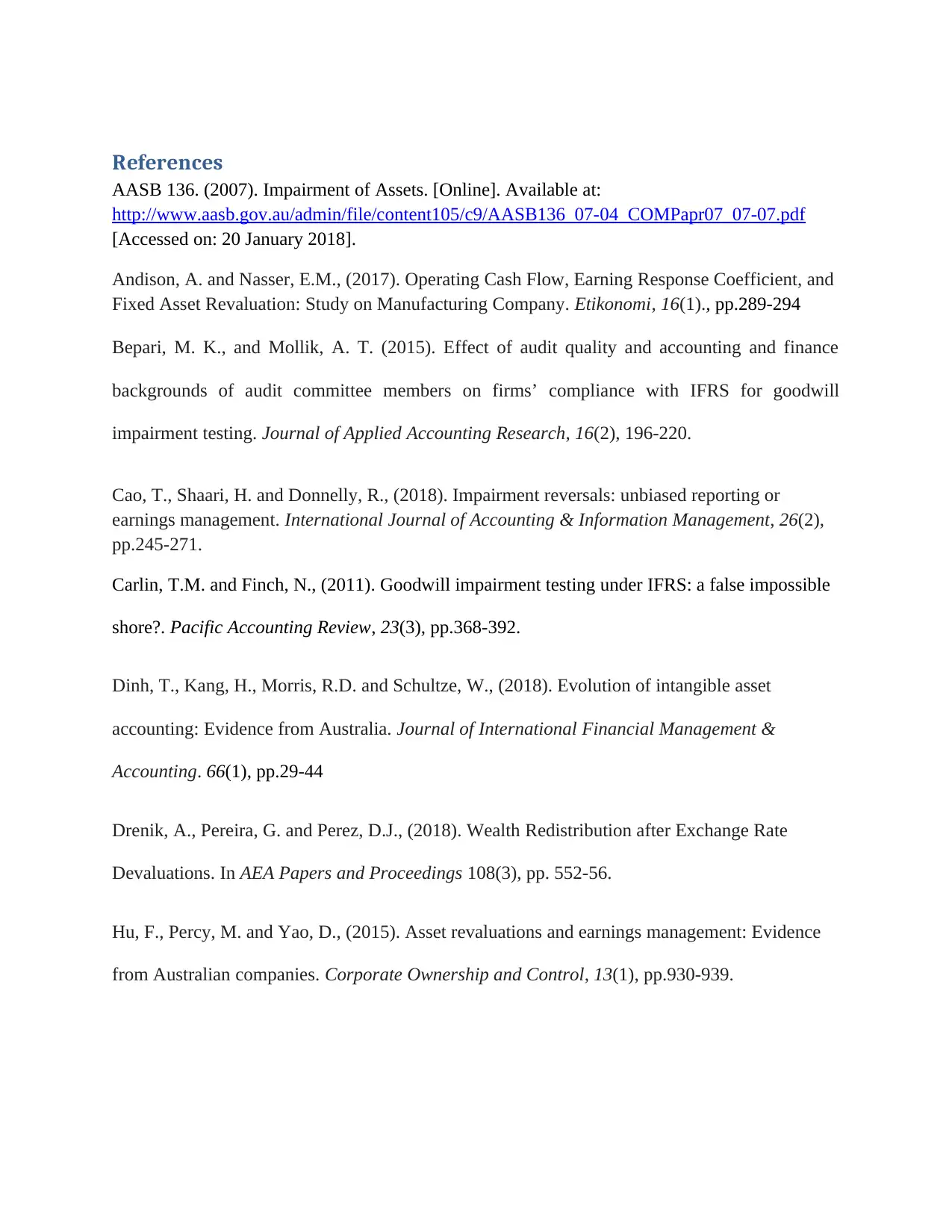
References
AASB 136. (2007). Impairment of Assets. [Online]. Available at:
http://www.aasb.gov.au/admin/file/content105/c9/AASB136_07-04_COMPapr07_07-07.pdf
[Accessed on: 20 January 2018].
Andison, A. and Nasser, E.M., (2017). Operating Cash Flow, Earning Response Coefficient, and
Fixed Asset Revaluation: Study on Manufacturing Company. Etikonomi, 16(1)., pp.289-294
Bepari, M. K., and Mollik, A. T. (2015). Effect of audit quality and accounting and finance
backgrounds of audit committee members on firms’ compliance with IFRS for goodwill
impairment testing. Journal of Applied Accounting Research, 16(2), 196-220.
Cao, T., Shaari, H. and Donnelly, R., (2018). Impairment reversals: unbiased reporting or
earnings management. International Journal of Accounting & Information Management, 26(2),
pp.245-271.
Carlin, T.M. and Finch, N., (2011). Goodwill impairment testing under IFRS: a false impossible
shore?. Pacific Accounting Review, 23(3), pp.368-392.
Dinh, T., Kang, H., Morris, R.D. and Schultze, W., (2018). Evolution of intangible asset
accounting: Evidence from Australia. Journal of International Financial Management &
Accounting. 66(1), pp.29-44
Drenik, A., Pereira, G. and Perez, D.J., (2018). Wealth Redistribution after Exchange Rate
Devaluations. In AEA Papers and Proceedings 108(3), pp. 552-56.
Hu, F., Percy, M. and Yao, D., (2015). Asset revaluations and earnings management: Evidence
from Australian companies. Corporate Ownership and Control, 13(1), pp.930-939.
AASB 136. (2007). Impairment of Assets. [Online]. Available at:
http://www.aasb.gov.au/admin/file/content105/c9/AASB136_07-04_COMPapr07_07-07.pdf
[Accessed on: 20 January 2018].
Andison, A. and Nasser, E.M., (2017). Operating Cash Flow, Earning Response Coefficient, and
Fixed Asset Revaluation: Study on Manufacturing Company. Etikonomi, 16(1)., pp.289-294
Bepari, M. K., and Mollik, A. T. (2015). Effect of audit quality and accounting and finance
backgrounds of audit committee members on firms’ compliance with IFRS for goodwill
impairment testing. Journal of Applied Accounting Research, 16(2), 196-220.
Cao, T., Shaari, H. and Donnelly, R., (2018). Impairment reversals: unbiased reporting or
earnings management. International Journal of Accounting & Information Management, 26(2),
pp.245-271.
Carlin, T.M. and Finch, N., (2011). Goodwill impairment testing under IFRS: a false impossible
shore?. Pacific Accounting Review, 23(3), pp.368-392.
Dinh, T., Kang, H., Morris, R.D. and Schultze, W., (2018). Evolution of intangible asset
accounting: Evidence from Australia. Journal of International Financial Management &
Accounting. 66(1), pp.29-44
Drenik, A., Pereira, G. and Perez, D.J., (2018). Wealth Redistribution after Exchange Rate
Devaluations. In AEA Papers and Proceedings 108(3), pp. 552-56.
Hu, F., Percy, M. and Yao, D., (2015). Asset revaluations and earnings management: Evidence
from Australian companies. Corporate Ownership and Control, 13(1), pp.930-939.
⊘ This is a preview!⊘
Do you want full access?
Subscribe today to unlock all pages.

Trusted by 1+ million students worldwide
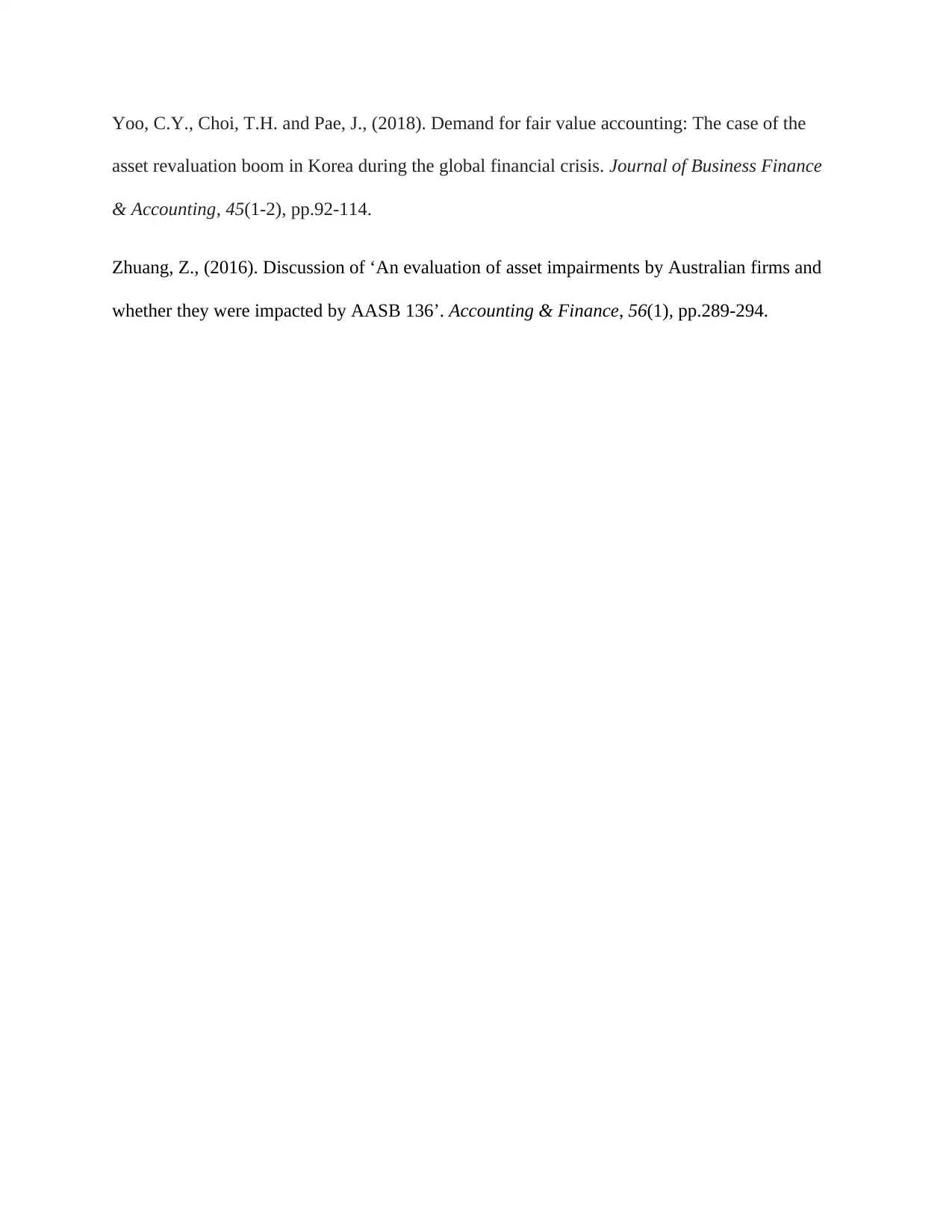
Yoo, C.Y., Choi, T.H. and Pae, J., (2018). Demand for fair value accounting: The case of the
asset revaluation boom in Korea during the global financial crisis. Journal of Business Finance
& Accounting, 45(1-2), pp.92-114.
Zhuang, Z., (2016). Discussion of ‘An evaluation of asset impairments by Australian firms and
whether they were impacted by AASB 136’. Accounting & Finance, 56(1), pp.289-294.
asset revaluation boom in Korea during the global financial crisis. Journal of Business Finance
& Accounting, 45(1-2), pp.92-114.
Zhuang, Z., (2016). Discussion of ‘An evaluation of asset impairments by Australian firms and
whether they were impacted by AASB 136’. Accounting & Finance, 56(1), pp.289-294.
Paraphrase This Document
Need a fresh take? Get an instant paraphrase of this document with our AI Paraphraser
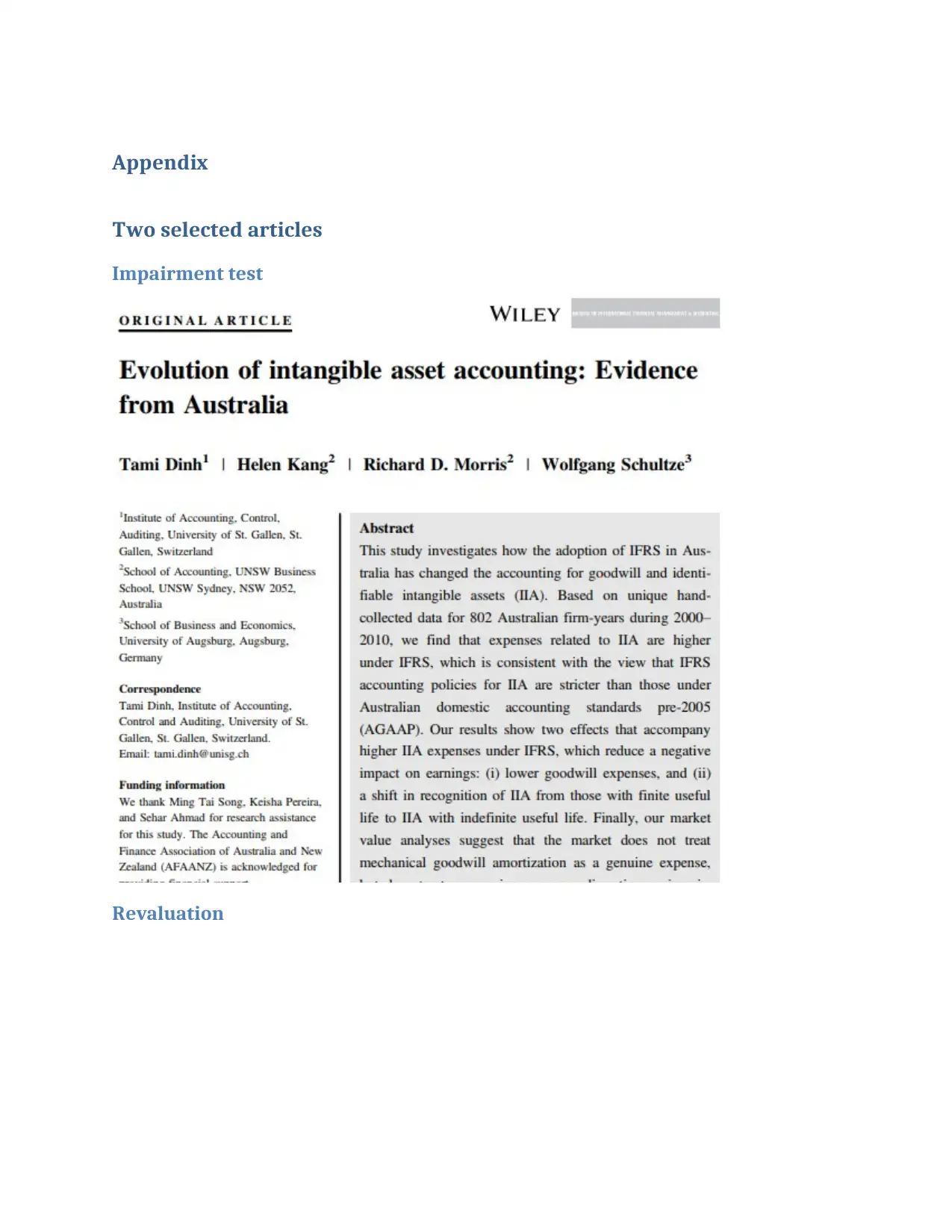
Appendix
Two selected articles
Impairment test
Revaluation
Two selected articles
Impairment test
Revaluation
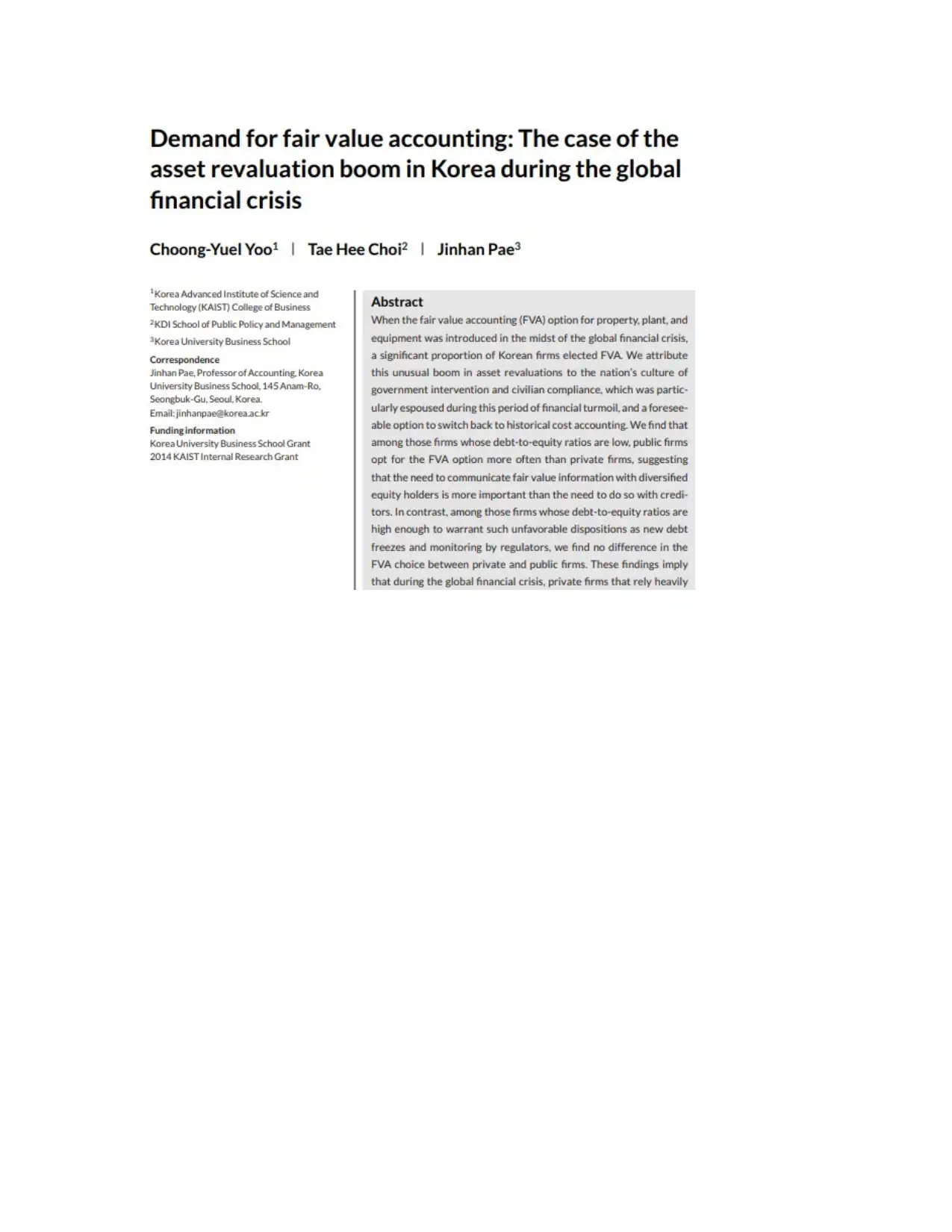
⊘ This is a preview!⊘
Do you want full access?
Subscribe today to unlock all pages.

Trusted by 1+ million students worldwide
1 out of 12
Related Documents
Your All-in-One AI-Powered Toolkit for Academic Success.
+13062052269
info@desklib.com
Available 24*7 on WhatsApp / Email
![[object Object]](/_next/static/media/star-bottom.7253800d.svg)
Unlock your academic potential
Copyright © 2020–2025 A2Z Services. All Rights Reserved. Developed and managed by ZUCOL.




